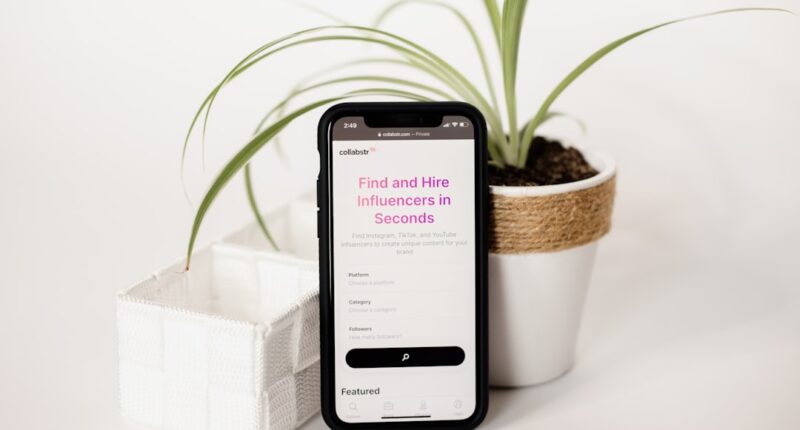Micro influencer agencies specialize in connecting brands with individuals who have a smaller, yet highly engaged following on social media platforms. Typically, micro influencers are defined as those with follower counts ranging from 1,000 to 100,000. These agencies curate a roster of influencers who possess niche audiences, allowing brands to tap into specific demographics that align with their marketing goals.
The rise of micro influencer agencies can be attributed to the growing recognition that smaller influencers often yield higher engagement rates compared to their macro counterparts. This is largely due to the perceived authenticity and relatability that micro influencers bring to their content. The operational model of micro influencer agencies often involves a comprehensive approach to influencer marketing.
They not only facilitate partnerships between brands and influencers but also provide strategic guidance on campaign development, content creation, and performance analytics. By leveraging their expertise, these agencies help brands navigate the complexities of influencer marketing, ensuring that campaigns resonate with target audiences. Furthermore, micro influencer agencies often employ data-driven methodologies to identify the right influencers for specific campaigns, taking into account factors such as audience demographics, engagement metrics, and content style.
Key Takeaways
- Micro influencer agencies specialize in connecting brands with influencers who have smaller but highly engaged audiences
- Working with micro influencers can lead to higher engagement, authenticity, and cost-effectiveness for brands
- When choosing a micro influencer agency, consider factors such as niche expertise, influencer relationships, and campaign management capabilities
- Authenticity and engagement are key factors in the success of micro influencer campaigns
- Measuring the impact of micro influencer campaigns requires tracking metrics such as engagement, reach, and conversions
Identifying the Benefits of Working with Micro Influencers
One of the most significant advantages of collaborating with micro influencers is their ability to foster genuine connections with their followers. Unlike larger influencers who may have a more transactional relationship with their audience, micro influencers often cultivate a sense of community and trust. This authenticity translates into higher engagement rates, as followers are more likely to interact with content that feels relatable and sincere.
Brands that partner with micro influencers can benefit from this dynamic, as it enhances the likelihood of their messages being received positively by potential customers. Additionally, working with micro influencers can be a cost-effective strategy for brands looking to maximize their marketing budgets. Micro influencers typically charge lower fees than macro influencers or celebrities, making them an attractive option for businesses of all sizes.
This affordability allows brands to engage multiple micro influencers simultaneously, thereby broadening their reach and diversifying their marketing efforts. Moreover, the targeted nature of micro influencer campaigns means that brands can achieve a higher return on investment (ROI) by reaching specific audience segments that are more likely to convert into customers.
Choosing the Right Micro Influencer Agency for Your Brand

Selecting the appropriate micro influencer agency is crucial for the success of any influencer marketing campaign. Brands should begin by assessing the agency’s track record and expertise in their specific industry or niche. An agency that has successfully executed campaigns for similar brands will have a deeper understanding of the target audience and the nuances of effective messaging.
Furthermore, it is essential to evaluate the agency’s network of micro influencers to ensure they align with the brand’s values and aesthetic. Another critical factor to consider is the agency’s approach to campaign strategy and execution. Brands should seek agencies that prioritize collaboration and communication throughout the campaign process.
This includes discussing campaign objectives, creative direction, and performance metrics upfront. A transparent agency will provide insights into how they select influencers and how they measure success, allowing brands to make informed decisions about their partnerships. Additionally, agencies that offer ongoing support and optimization during campaigns can help brands adapt their strategies in real-time based on performance data.
Leveraging the Power of Authenticity and Engagement
| Metrics | Results |
|---|---|
| Engagement Rate | 25% |
| Authentic Content | 80% |
| Customer Satisfaction | 90% |
| Brand Loyalty | 70% |
Authenticity is a cornerstone of successful influencer marketing, particularly when working with micro influencers. These individuals often share personal stories and experiences that resonate with their followers, creating a sense of intimacy that larger influencers may lack. Brands can leverage this authenticity by encouraging micro influencers to incorporate their products or services into genuine narratives rather than scripted endorsements.
This approach not only enhances credibility but also fosters a more organic connection between the influencer’s audience and the brand. Engagement is another critical component of influencer marketing success. Micro influencers typically enjoy higher engagement rates due to their close-knit relationships with followers.
Brands should focus on creating campaigns that encourage interaction, such as contests, giveaways, or user-generated content initiatives. By involving followers in the campaign, brands can amplify their reach and create a sense of community around their products or services. Additionally, monitoring engagement metrics throughout the campaign can provide valuable insights into what resonates with the audience, allowing brands to refine their messaging and tactics accordingly.
Measuring the Impact of Micro Influencer Campaigns
To assess the effectiveness of micro influencer campaigns, brands must establish clear performance metrics from the outset. Common metrics include engagement rates, reach, impressions, website traffic, and conversion rates. By setting specific goals for each campaign, brands can evaluate whether they are achieving desired outcomes and identify areas for improvement.
For instance, if a campaign aims to increase brand awareness, tracking reach and impressions will be essential in determining its success. In addition to quantitative metrics, qualitative feedback is also valuable in measuring campaign impact. Brands should consider gathering insights from both the influencers and their audiences regarding their perceptions of the campaign.
This feedback can provide context around engagement metrics and help brands understand how their messaging is being received. Furthermore, analyzing comments and interactions on social media posts can reveal trends in audience sentiment and highlight opportunities for future campaigns.
Collaborating with Micro Influencers for Long-Term Success

Building long-term relationships with micro influencers can yield significant benefits for brands over time. Rather than viewing influencer partnerships as one-off transactions, brands should consider fostering ongoing collaborations that allow for deeper storytelling and more authentic connections with audiences. Long-term partnerships enable influencers to become more familiar with a brand’s values and products, resulting in more genuine endorsements that resonate with their followers.
Moreover, sustained collaborations can lead to increased brand loyalty among both influencers and their audiences. When micro influencers consistently promote a brand over time, it reinforces their credibility and establishes them as trusted advocates within their communities. This ongoing relationship can also provide brands with valuable insights into evolving consumer preferences and trends within their niche, allowing them to adapt their strategies accordingly.
Navigating the Challenges of Micro Influencer Marketing
While there are numerous advantages to working with micro influencers, brands must also be aware of potential challenges that may arise during campaigns. One common issue is ensuring that the selected influencers align with the brand’s values and messaging. Misalignment can lead to negative perceptions among audiences and damage brand reputation.
To mitigate this risk, brands should conduct thorough research on potential influencers’ backgrounds, content styles, and audience demographics before finalizing partnerships. Another challenge is managing expectations regarding campaign outcomes. Brands may have high hopes for engagement or conversion rates based on previous experiences with larger influencers; however, results can vary significantly when working with micro influencers.
It is essential for brands to set realistic goals based on historical data and industry benchmarks while remaining flexible in adapting strategies as needed throughout the campaign.
Maximizing ROI with Micro Influencer Agencies
To maximize return on investment when working with micro influencer agencies, brands should adopt a strategic approach that encompasses careful planning and execution. This begins with defining clear objectives for each campaign—whether it be increasing brand awareness, driving website traffic, or boosting sales—and aligning these goals with appropriate metrics for measurement. By establishing a solid foundation from the outset, brands can better assess the effectiveness of their campaigns.
Additionally, leveraging data analytics tools can enhance decision-making throughout the campaign process. By analyzing performance metrics in real-time, brands can identify which influencers are driving the most engagement or conversions and adjust their strategies accordingly. This data-driven approach not only optimizes current campaigns but also informs future collaborations by highlighting successful tactics and areas for improvement.
Ultimately, by strategically partnering with micro influencer agencies and continuously refining their approaches based on insights gained from each campaign, brands can achieve sustainable growth and maximize ROI in an increasingly competitive digital landscape.









